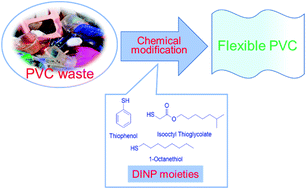Degradation of PVC waste into a flexible polymer by chemical modification using DINP moieties†
Abstract
In consideration of the toxicity and high migration capacity of plasticizers, the possibility to obtain flexible PVC via chemical modification of PVC was investigated for feedstock recycling. In this work, some Cl atoms of PVC were substituted with fragments of the common plasticizer DINP (diisononyl phthalate) in the presence of K2CO3 (potassium carbonate) or DIEA (N,N-diisopropylethylamine), and the simultaneous elimination of PVC was suppressed. 1H NMR (1H nuclear magnetic resonance spectroscopy) and 1H–1H COSY (1H–1H correlation spectroscopy) were used to evaluate the substitution while a novel method of calculating the substitution and elimination ratios was developed using a combination of 1H NMR and elemental analysis. A maximum substitution rate of 35.7% was achieved using thiophenol as a nucleophile in the presence of DIEA, while the corresponding elimination of HCl was just 4.4%. In addition, the thermal stability of the modified PVCs was very close to that of pure PVC, which suggested that the main characteristics of PVC were preserved. Moreover, the Tg values of all the modified PVCs were less than that of PVC, which means it is feasible to improve the plasticity of PVC via substituting some Cl on PVC with DINP moieties. Therefore, an alternative approach for feedstock recycling of PVC by chemical modification was developed in this work.



 Please wait while we load your content...
Please wait while we load your content...